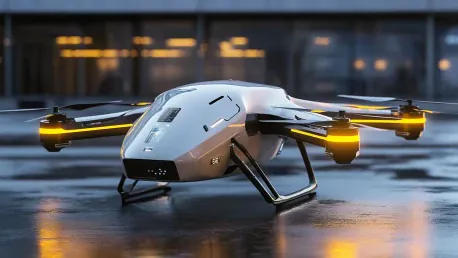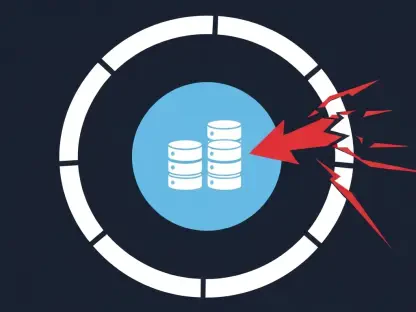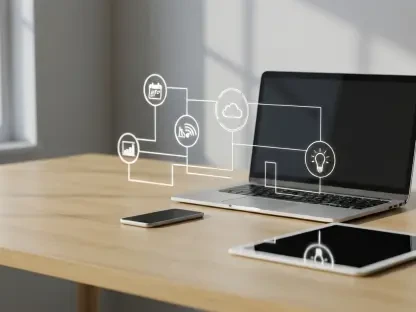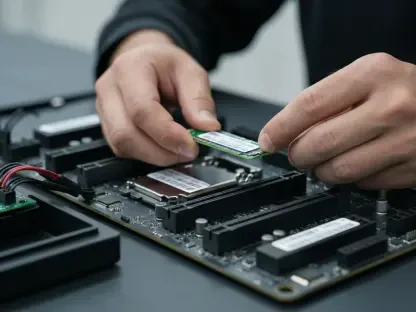The drone industry is on the precipice of monumental changes as it heads into 2025. Influential factors include a new U.S. administration, fresh leadership at the Federal Aviation Administration (FAA), and fluctuating global conflicts. These elements are expected to drive significant alterations in regulations, supply chains, and technological advancements. DRONELIFE, in its comprehensive review, consulted with leading industry experts to gather insights about the upcoming developments in regulatory shifts, AI-driven automation, national security concerns, and evolving business models.
Regulatory Shifts and BVLOS Operations
FAA Reauthorization Act of 2024
The FAA Reauthorization Act of 2024 is set to pave the way for safer and more efficient regulatory processes in 2025. This act will be instrumental in transitioning Beyond Visual Line of Sight (BVLOS) operations from waiver-based to rule-based frameworks. Sam Knight, Vice President of Product Management & Remote Pilot at Blue Marble Geographics, emphasized that this shift will allow for the integration of disruptive technologies within the U.S. drone industry. The new regulations are expected to revolutionize commercial and public sector applications, including vital emergency response efforts and autonomous systems.
The shift from waivers to rulemaking will streamline the regulatory landscape, reducing bureaucratic hurdles and encouraging innovation. For example, BVLOS operations will no longer require individual approvals, thus expediting the deployment of drones in critical scenarios such as disaster relief and agricultural monitoring. The expected legislative changes are also likely to spur further advancements in drone technology, with companies investing more in research and development to comply with the new standards.
Impact on Commercial and Public Sector Applications
The move towards BVLOS operations will significantly impact various sectors. For instance, emergency response efforts will benefit from the ability to deploy drones quickly and efficiently without the need for waivers. Autonomous systems will also see advancements, enabling more complex and longer-range missions. This regulatory shift will open up new opportunities for innovation and growth within the drone industry.
Commercial enterprises will see considerable benefits as well. Logistics companies can expand their delivery networks to remote areas, reducing costs and enhancing customer service. In the public sector, municipalities can utilize drones for infrastructure inspections, reducing the need for manual labor and minimizing risks associated with hazardous work environments. Additionally, BVLOS operations will facilitate the growth of new business models, such as drone-based delivery services, which are expected to become commonplace in urban and rural areas alike.
Technological Advancements and AI Integration
Role of AI in Drone Operations
A significant technological trend is the integration of artificial intelligence (AI) and automation within drone capabilities. Trevor Perrott, CEO & Co-Founder of Censys Technologies, points out that AI will play an essential role in managing larger data volumes resulting from BVLOS operations. By enabling real-time data processing, AI can convert raw data into actionable insights, improving efficiency across various industries. This evolution towards AI-driven autonomy is predicted to bolster critical operations in logistics, industrial inspections, and public safety.
The potential applications of AI in drone operations are vast and transformative. In logistics, AI can optimize delivery routes, reducing fuel consumption and operational costs while ensuring timely deliveries. Similarly, in industrial inspections, AI algorithms can analyze vast amounts of data to detect anomalies and predict maintenance needs, minimizing equipment downtime and preventing costly failures. Public safety agencies will also benefit from AI-enhanced drones capable of identifying and responding to emergencies more quickly and accurately, improving overall community safety.
Enhancing Efficiency and Safety
AI-driven automation will enhance the efficiency and safety of drone operations. For example, in logistics, AI can optimize delivery routes and schedules, reducing operational costs and improving delivery times. In industrial inspections, AI can analyze data to identify potential issues before they become critical, ensuring timely maintenance and reducing downtime. Public safety operations will also benefit from AI’s ability to process and analyze data quickly, enabling faster and more effective responses to emergencies.
Another aspect of safety enhancement is the development of advanced obstacle-avoidance systems powered by AI. These systems can react in real time to dynamic environments, preventing collisions with unexpected obstacles such as birds or other drones. Further, AI can improve flight path planning by predicting weather patterns and optimizing paths to avoid hazardous conditions. Consequently, the integration of AI into drone technology will not only improve operational efficiency but also significantly enhance the safety and reliability of drone missions.
Security and Supply Chain Dynamics
National Security Concerns
Amid rising geopolitical tensions, national security and supply chain challenges remain a top concern. The Countering CCP Drones bill, aimed at restricting Chinese-made drones and components, is likely to bring significant changes. Peter Fuchs, Co-founder and CEO of Ascent AeroSystems, noted that the effects of this bill would extend beyond platforms like DJI, influencing the broader industry due to increased trade tensions and national security measures. This push for NDAA-compliant and domestically manufactured drones is anticipated to reshape the competitive landscape, spurring investments in advanced multi-mission platforms.
The national security focus on limiting foreign influence within the drone industry will lead to a more robust and secure domestic manufacturing base. This shift will encourage American companies to develop sophisticated and secure drone technologies that adhere to stringent safety and security standards. Additionally, the emphasis on NDAA compliance will likely catalyze partnerships between technology firms and defense contractors, driving innovations in drone capabilities tailored to national security applications and ensuring a reliable supply chain free from geopolitical risks.
Impact on Supply Chains
The restrictions on Chinese-made drones and components will have a profound impact on supply chains. Companies will need to source alternative components and materials, potentially leading to increased costs and longer lead times. However, this shift also presents opportunities for domestic manufacturers to innovate and capture market share. The focus on NDAA-compliant drones will drive investments in research and development, leading to the creation of more advanced and secure drone technologies.
Moreover, the pivot to domestically sourced components may foster the creation of new suppliers and the expansion of existing ones, contributing to economic growth and technological independence. While the initial transition period may pose challenges due to supply chain disruptions and higher production costs, the long-term benefits of having a self-sufficient and secure drone industry cannot be understated. This move will likely result in more competitive, high-quality drones that are less susceptible to external market fluctuations and international trade constraints.
UTM, U-Space, and Global Integration
Adoption of UTM and U-Space Frameworks
As urban air mobility and commercial drone operations evolve, the integration of Unmanned Traffic Management (UTM) and U-Space frameworks will be crucial. Amit Ganjoo from Anra Technologies predicts that 2025 will witness significant advances in the adoption and commercial rollout of certified UTM and U-Space systems. These regulatory frameworks, like EASA’s U-Space, will set global benchmarks in safety, automation, and interoperability, encouraging global adoption of standard practices for drone integration into shared airspaces.
The UTM and U-Space frameworks are expected to provide the necessary infrastructure for the real-time management of drone traffic, ensuring a harmonious integration with manned aviation. By incorporating advanced telemetry and geofencing technologies, these frameworks will enable drones to operate safely and efficiently in congested urban environments. Furthermore, standardized communication protocols and automated conflict resolution systems will be critical in preventing mid-air collisions and maintaining orderly traffic flow within shared airspaces.
Global Standards and Interoperability
The establishment of global standards and interoperability will be essential for the seamless integration of drones into shared airspaces. UTM and U-Space frameworks will provide the necessary guidelines for safe and efficient drone operations, reducing the risk of collisions and other incidents. These frameworks will also facilitate international collaboration and the exchange of best practices, driving the global growth of the drone industry.
By adopting universal standards, countries can create a cohesive and reliable system for managing drone traffic, making cross-border operations more feasible and safer. This global cooperative effort will reduce regulatory barriers and enable the widespread deployment of commercial drone services, from package delivery to aerial surveys, across different regions. Additionally, the synergy between UTM and U-Space will pave the way for economic opportunities and advancements in technology, benefiting stakeholders globally and ensuring continuous innovation in the drone sector.
Environmental Applications and Sustainability
Drones in Environmental Monitoring
Drones are increasingly becoming instrumental in environmental monitoring and sustainability initiatives. Sukhee Cho, Vice President at Hojung Solutions, highlights the rising demand for carbon credits and the growing commitment towards net-zero frameworks. Drones can provide precise, real-time data on emissions and environmental metrics, reinforcing the credibility of carbon offset initiatives. The real-time monitoring capabilities of drones ensure that data is accurate and up-to-date, providing valuable insights that can be used to track and manage environmental impacts effectively.
These advancements play a crucial role in various environmental applications, including wildlife monitoring, forest management, and pollution tracking. Drones equipped with sophisticated sensors can measure particulate matter, greenhouse gas emissions, and other pollutants, offering valuable data for environmental researchers and policy-makers. By providing actionable insights, drones enhance the ability to implement effective conservation strategies and compliance with environmental regulations. This convergence of technology and environmental stewardship presents a promising market for UAV companies specializing in sustainability-focused applications.
Supporting Sustainability Initiatives
Drones are becoming a crucial tool in the arsenal for achieving sustainability goals. By providing high-resolution images and data, drones help in assessing land-use changes, monitoring deforestation, and evaluating the health of ecosystems. They can quickly cover vast areas that are otherwise difficult to access, thus providing a more comprehensive overview of environmental conditions. This ability supports the creation and verification of carbon credits, ensuring they are based on accurate, current data.
Additionally, drones contribute to sustainable agriculture by enabling precision farming techniques. They can monitor crop health, optimize irrigation, and detect pest infestations early, thus reducing the need for chemical inputs and increasing yield efficiency. In the construction sector, drones help in minimizing environmental impact assessments by providing detailed topographical maps and monitoring construction site progress. Through these diverse applications, drones drive forward sustainability efforts across multiple sectors, highlighting their integral role in a greener future.
Consolidated Insights and Conclusion
The drone industry is poised for significant transformation as it approaches 2025. Key driving forces include changes with a new U.S. administration, shifts in leadership at the Federal Aviation Administration (FAA), and dynamic global conflicts. These factors are anticipated to lead to considerable modifications in regulations, supply chains, and technological advancements. In a detailed analysis, DRONELIFE engaged with leading experts in the industry to understand the forthcoming changes. These experts provided valuable insights into potential regulatory adjustments, the rise of AI-driven automation, heightened national security concerns, and the evolution of business models within the drone sector. The collective expertise points to a future where drones will not only become more integrated into various sectors but also more advanced in their capabilities, driven by both technological innovation and regulatory evolution. The insights gathered highlight the complex interplay of these factors and underscore the significant impact they will have on the growth and development of the drone industry as we head towards 2025.









